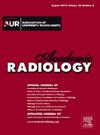Large Language Models with Vision on Diagnostic Radiology Board Exam Style Questions
IF 3.8
2区 医学
Q1 RADIOLOGY, NUCLEAR MEDICINE & MEDICAL IMAGING
引用次数: 0
Abstract
Rationale and Objectives
The expansion of large language models to process images offers new avenues for application in radiology. This study aims to assess the multimodal capabilities of contemporary large language models, which allow analysis of image inputs in addition to textual data, on radiology board-style examination questions with images.
Materials and Methods
280 questions were retrospectively selected from the AuntMinnie public test bank. The test questions were converted into three formats of prompts; (1) Multimodal, (2) Image-only, and (3) Text-only input. Three models, GPT-4V, Gemini 1.5 Pro, and Claude 3.5 Sonnet, were evaluated using these prompts. The Cochran Q test and pairwise McNemar test were used to compare performances between prompt formats and models.
Results
No difference was found for the performance in terms of % correct answers between the text, image, and multimodal prompt formats for GPT-4V (54%, 52%, and 57%, respectively; p = .31) and Gemini 1.5 Pro (53%, 54%, and 57%, respectively; p = .53). For Claude 3.5 Sonnet, the image input (48%) significantly underperformed compared to the text input (63%, p < .001) and the multimodal input (66%, p < .001), but no difference was found between the text and multimodal inputs (p = .29). Claude significantly outperformed GPT and Gemini in the text and multimodal formats (p < .01).
Conclusion
Vision-capable large language models cannot effectively use images to increase performance on radiology board-style examination questions. When using textual data alone, Claude 3.5 Sonnet outperforms GPT-4V and Gemini 1.5 Pro, highlighting the advancements in the field and its potential for use in further research.
大型语言模型与视觉诊断放射委员会考试风格的问题。
基本原理和目标:扩展大型语言模型来处理图像为放射学的应用提供了新的途径。本研究旨在评估当代大型语言模型的多模态能力,该模型允许分析图像输入和文本数据,以及带有图像的放射学板式考试问题。材料和方法:回顾性地从明尼大学公开考试题库中抽取280道试题。测试问题被转换成三种格式的提示;(1)多模式输入,(2)纯图像输入,(3)纯文本输入。使用这些提示对GPT-4V、Gemini 1.5 Pro和Claude 3.5 Sonnet三种模型进行了评估。采用Cochran Q检验和成对McNemar检验比较提示格式和模型的表现。结果:GPT-4V的文本、图像和多模态提示格式在正确率方面没有差异(分别为54%、52%和57%);p = 0.31)和Gemini 1.5 Pro(分别为53%、54%和57%;p = .53)。对于Claude 3.5 Sonnet,图像输入(48%)的表现明显低于文本输入(63%),p结论:具有视觉能力的大型语言模型不能有效地使用图像来提高放射学板式考试问题的表现。当单独使用文本数据时,Claude 3.5 Sonnet优于GPT-4V和Gemini 1.5 Pro,突出了该领域的进步及其在进一步研究中的应用潜力。
本文章由计算机程序翻译,如有差异,请以英文原文为准。
求助全文
约1分钟内获得全文
求助全文
来源期刊

Academic Radiology
医学-核医学
CiteScore
7.60
自引率
10.40%
发文量
432
审稿时长
18 days
期刊介绍:
Academic Radiology publishes original reports of clinical and laboratory investigations in diagnostic imaging, the diagnostic use of radioactive isotopes, computed tomography, positron emission tomography, magnetic resonance imaging, ultrasound, digital subtraction angiography, image-guided interventions and related techniques. It also includes brief technical reports describing original observations, techniques, and instrumental developments; state-of-the-art reports on clinical issues, new technology and other topics of current medical importance; meta-analyses; scientific studies and opinions on radiologic education; and letters to the Editor.
 求助内容:
求助内容: 应助结果提醒方式:
应助结果提醒方式:


